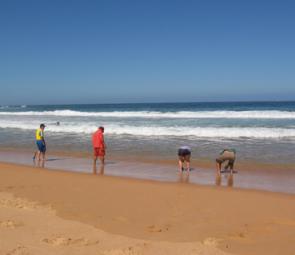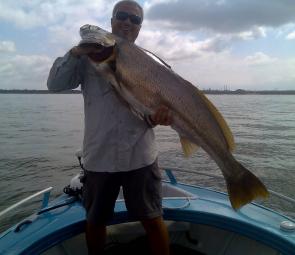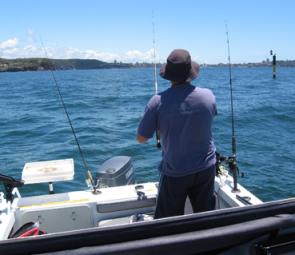I frequently in these reports mention the need to berley to improve your catch rate.
This month I will be fishing the estuaries, bays, beaches and rocks and I find that the need to berley when bait fishing is critical about 98% of the time. I will be chasing bream, flathead, trevally, drummer, snapper, tailor and luderick, with the odd kingfish and mulloway thrown in.
To help you understand a bit more about how I berley, here are examples for fishing in the estuaries and bays and off the beaches and rocks.
I reckon those anglers who don’t use berley are mad because it has to be the most effective way of attracting the fish to you. But when using berley, no matter what the combination is, you need to use it to bring the fish to you while at the same time not feeding them so that they fill up on your berley.
The main thing that you have got to remember is that the largest object that should be floating down that berley trail is your bait with a hook in it.
The trick to successful berleying is to have the correct combination of ingredients, consistency of the flow and timing.
I use a variety of ingredients and combinations in my berley to attract the fish species I am targeting on the day. Ingredients include bread, chicken layer pellets, dog or cat food (larger pellets), pilchards, prawn heads and shells, fish frames, chopped weed and green cabbage, wheat, breadcrumbs, tuna oil, bran and various fish scraps.
Whether you are fishing from a boat or the shore, you should use berley in an estuary or bay to maximise your chances of tangling with the fish of your choice. If I am after bream and snapper in about 2m to 6m of water where the flow is almost stopped, I use a combination of pilchards and chicken layer pellets chopped up in a berley container.
This allows the berley to gently float down and not race away in a fast-flowing current.
If the current was reasonably quick in the same depth, I use a combination of dog or cat pellets, chicken layer pellets and small pieces of chopped pilchards. Instead of dispersing through the berley pot I throw out a handful of the larger dog or cat pellets, then a handful of chicken layer pellets, followed by a few pieces of chopped pilchards.
The order of this is critical because the dog or cat pellets sink the fastest, then the chicken pellets, followed by the pilchards, giving you an even spread through the water column and over the seabed.
You should repeat this process say every five to 10 minutes until you start to catch your target fish. Once they are in the berley trail you should not have to do it as often. This same technique could be used to attract mulloway to the back of your boat from a reef or other structure.
If you are fishing from a breakwall for mulloway you could try a combination of the larger dog or cat pellets, half-pilchards and chunks of mullet. These ingredients should be placed into a 20-litre bucket and thrown out into the water at about every 10 minutes.
The main thing is to ensure the current does not take the berley away too quickly, taking the fish away with it. You may have to throw the berley upstream to allow it to sink before it gets to where you are fishing.
Whether from a boat or the shore, I use a float rig to chase luderick. In your berley you need finely chopped green weed and sand, and you’ll also need water movement, consistency and accurate berley placement.
I prefer to have my boat anchored at 90° to the shoreline so that there is no swaying from side to side of the boat, allowing me to keep direct contact with the float.
Once I have started the float on its drift away from the boat, I lob a handful of the berley around it. This ensures that as the berley sinks it stays in the area of the float and the bait.
To keep luderick in the berley trail you need to maintain a reasonably steady flow of berley and when you have hooked a fish, this is usually a good time to throw another handful. The sand in the berley gives the green weed some weight to get it down to where the fish are feeding.
Off the beach I always have some kind of bait bucket strapped to my waist and a berley bucket as well. A cut-out plastic milk bottle is fine. I tend to use chopped pilchards and every now and then I throw a handful as far out into the surf as I can.
This type of berleying will attract tailor, bream and whiting, among other fish. Again, make sure that your bait is much larger than the berley particles.
If you intend to fish just one area of beach you can always build a cylindrical berley cage from bird wire, fill it with fish and attach a length of rope. Anchor it to the sand by two spikes and the wave action will release the berley.
I never fish off the rocks without berley. Luderick are very responsive to a berley of finely chopped green weed or cabbage.
Whether you are fishing in a wash, gutter, off sloping rocks or a flat platform, there needs to be some kind of water movement when fishing for luderick. This comes mainly from the tide and swell.
In many rock fishing locations you will find small tufts of green, brown or black ‘cabbage’ weed that you can use for bait and scrape off for berley with the cleats or spikes on the bottoms of your shoes. The swell and tide will carry the berley away from the rocks and hopefully bring the luderick to where your float is. You should scrape some cabbage off before you start to get your gear rigged and then every time that you move about on the rocks.
But you should always check first that your chosen fishing area is not part of a marine park or protected area before doing this.
If you are targeting mulloway off the rocks you could always get yourself a tuna or a bonito and tie a rope around the tail and lash the other end to the rocks. The whole fish is then put into the water and allowed to wash around, the waves breaking off small pieces every now and then. This berley will attracting the larger predators in closer.
Another method is to put some fish frames, heads and pilchards into a small mesh bag and secure it to the rocks where you are fishing and allow the waves to slowly release berley into the wash.
Remember, your job is not to feed the fish with your berley but to attract them to your bait with its aroma and taste.
Steve caught this 20kg jewfish in Botany Bay around 8.30am on 10 kg braid and a 15 kg leader.
Reads: 8342

When it comes to catching beach worms you will need to berley to get the worms to poke their heads up.


Fishing at Sow and Pigs on Sydney Harbour. This crew was the only one out of eight boats berleying –guess who caught the fish?




